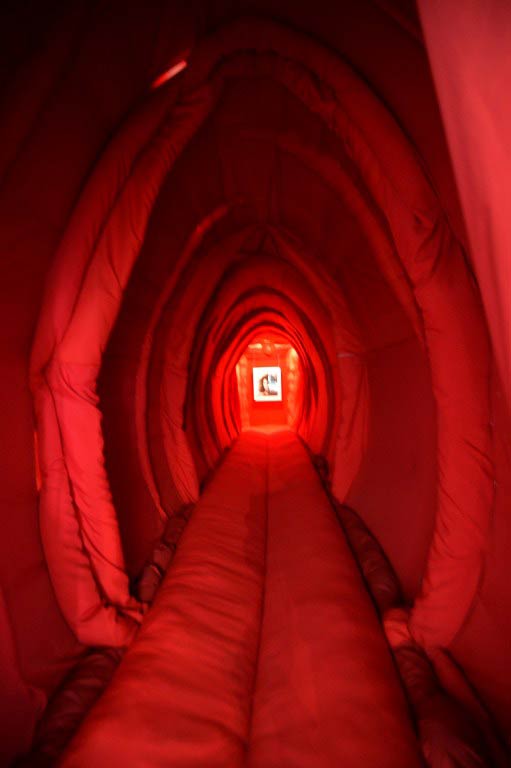It lets out a high-pitched scream as you enter, then a sneering laugh. It’s a walk-in vagina, a conceptual art installation that has South Africans wagging their fingers and scratching their heads.
When 30-year-old South African artist Reshma Chhiba was asked to produce artwork for a disused apartheid-era women’s jail in Johannesburg, she wanted to make a statement about women’s power.
What she came up with was a talking “yoni”, or vagina in India’s ancient language, Sanskrit.
“It’s a screaming vagina within a space that once contained women and stifled women,” she told AFP. “It’s revolting against this space… mocking this space, by laughing at it.”
Visitors enter the 12m red padded velvet and cotton canal by first stepping onto a tongue-like padding. Thick, black acrylic wool mimics pubic hair around the opening.

The shrill soundtrack that assaults visitors as they stroll through the tunnel is a revolt against the women’s jail, built in 1909, that held some of South Africa’s leading anti-apartheid activists.
Winnie Madikizela-Mandela was incarcerated there twice in 1958 and 1976.
“I definitely did not make this work for the sake of controversy,” said Chhiba.
For her, it was about artistic freedom and challenging deeply entrenched patriarchal systems .
“You don’t often hear men talking about their private parts and feeling disgust or shamed,” as women often do, she said.
“And that alone speaks volumes of how we’ve been brought up to think about our bodies, and what I am saying here is that it’s supposed to be an empowering space.”
The artist also wanted to address the scourge of rape in South Africa, where nearly 65 000 attacks on girls and women are reported a year in one of the highest incidences of rape in the world – with little improvement.
But the installation, on display throughout August, has collided with some sensitive cultural and religious taboos.
“It’s the most private part of my body. I grew up in the rural areas, we were taught not to expose your body, even your thighs let alone your vagina,” said Benathi Mangqaaleza, 24-year-old female security guard at the former prison that is now a tourist site.
“I think it’s pornographic, I think they have gone too far.”
‘A sacred space’
Twenty-four-year-old gardener Andile Wayi thought the exhibition — on the site of the Victorian-era brick women’s jail and another that once held Mahatma Gandhi – as well as the Constitutional Court – was wrong.
“The [Constitution] Hill is respected, it’s a heritage,” he said.
The fine arts graduate,who is also a practising Hindu, has spent years of research into the Hindu goddess Kali whom she views as a symbol of defiance.
She expressed “shock” at the media onslaught and allegations of blasphemy from some Hindu followers who complained through radio talk shows.
“To talk about the vagina, or visualise it, is something that is not out of the ordinary,” she insisted
The exhibition, entitled “The Two Talking Yonis”, was the product of two years of discussion with curator Nontobeko Ntombela on the mythology of female power in patriarchal systems.
Visitors have to take off their shoes to walk through the softly cushioned canal.
“By talking off your shoes, essentially you are respecting it, making it a divine space, a sacred space,” said Chhiba.
Gender Links, a lobby group promoting gender equality in southern Africa, praises Chhiba’s artwork for re-igniting discussion on a subject normally avoided.
“It is bringing the private into the public, that the woman’s body is not necessarily a private matter,” said Kubi Rama, Gender Links boss.
Comments are closed.